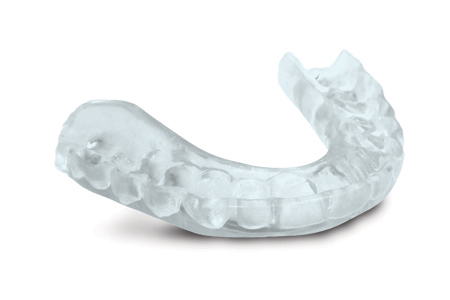The Ultimate Smile Makeover Experience! Where Custom Smiles are Created™
Night Guards/Bite Splints
Night guards and bite splints offer the comfort of a patient-specific fit, perfect for treating bruxers or protecting enamel from wear caused by opposing restorations. Elle Jordan Studio's night guards are available in traditional hard or hard-soft, which softens in hot tap water for a more comfortable fit.
Nightguards are indicated for patients that show increased tooth wear due to bruxing or clenching.
Sportsguards mouthguards are indicated for patients who desire protection against dental trauma (i.e. fractured teeth, concussions, etc.) and/or have an orthodontic situation such as braces and must wear a mouthguard.
Contraindications
Sportsguard mouthguards should not be used in lieu of Nightguards or TMJ splints.
Nightguards
Start with an accurate, void-free impression of both arches. Ensure no tears or bubbles are present in impression material for precision fit. Instruct patient to close into centric relation to verify midline position and bite. Then, place two cotton rolls behind the cuspids and instruct patient to close; with patient in open bite, inject bite registration into the posterior openings of both quadrants. In addition, inject bite registration into anterior opening to capture a complete open construction bite.
Sportsguards
Start with an accurate bite registration and void-free impression using a custom tray.
Sportsguards
We require upper and lower models, including a bite registration of 3mm thickness at a rest position. (This lets the tech adjust the mouthguard to the patient’s proper vertical.) We can proceed without a bite, but the doctor may need to adjust the Sportsguard if it is hitting on the posteriors first. To get the most accurate oral fit, we need an opposing model and bite. We can fabricate without an opposing, but the doctor may need to do adjustments and there would be no cuspid indentation.
Adjustments:
If an adjustment is required, the doctor may use an arbor band disc to adjust and then repolish with a butane flame. To re-attach a helmet strap, heat the end of the strap, insert into mouthguard’s keyway and then hold until cooled off. If there are any further questions or if a serious adjustment is needed, it is recommended to send the mouthguard back to the laboratory.
Ensure an accurate impression of all soft and hard tissue areas, especially the vestibule and peripheral areas. Capturing the vestibule areas is critical as this helps with proper retention and protection.
If a Sportsguard is made for a patient with orthodontic brackets, the arch wire must be removed to allow for accurate impression.
Sportsguards
Brush and floss your teeth before placing the appliance in your mouth
Clean your appliance after every use with a denture toothbrush and toothpaste under cool water. If a white film starts to form or to eliminate odors, soak appliance in denture cleaning solution (such as Polident or Efferdent®).
After cleaning, rinse appliance under cool water. Completely air dry before storing.
DO NOT soak the appliance in mouthwash or alcohol. DO NOT place in hot or boiling water or expose to excessive heat, as this will distort the appliance.
Nightguards
Brush and floss your teeth before placing the appliance in your mouth.
DO NOT soak the appliance in mouthwash, denture cleaner or alcohol. DO NOT place in hot or boiling water or expose to excessive heat (such as direct sunlight), as this will distort the appliance.
Rinse well with water before and after use and store dry.
Clean the appliance with soap and warm water ONLY.
If it becomes loose, tight or causes you any discomfort, contact your dentist immediately.
- D9941 Fabrication of Athletic Mouthguards
- D9940 Nightguard

